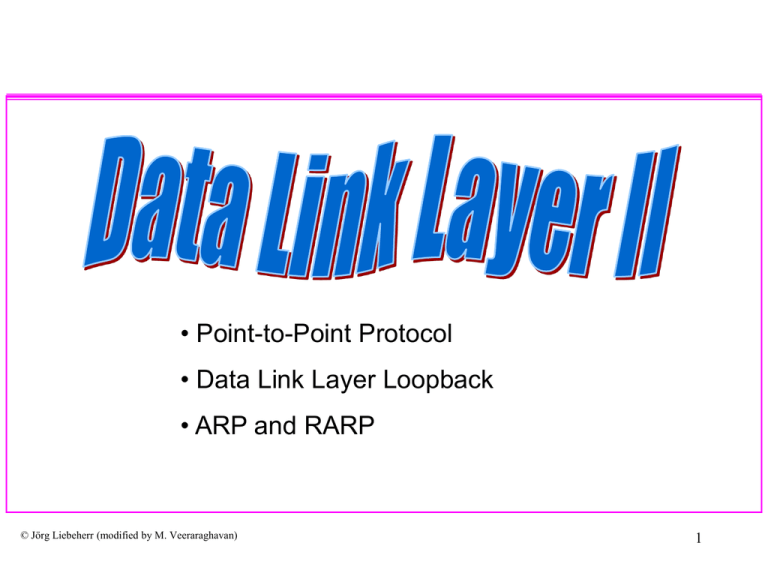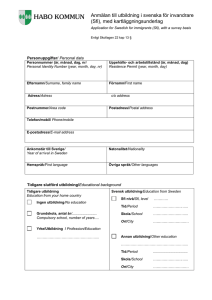ARP and RARP
advertisement

• Point-to-Point Protocol • Data Link Layer Loopback • ARP and RARP © Jörg Liebeherr (modified by M. Veeraraghavan) 1 Orientation • We are still talking about the Data Link Layer. Network Layer Data Link Layer Network Layer Data Link Layer Physical Layer Physical Layer • Last Lecture we discussed protocols in broadcast LAN networks. © Jörg Liebeherr (modified by M. Veeraraghavan) 2 Orientation 2 Data Link Layer • We learned that in broadcast LANs, the Link Layer is divided in two sublayers: to Network Layer – Media Access Control (MAC) Logical Link Control – Logical Link Control (LLC) Medium Access Control to Physical Layer • We discussed the IEEE 802 family of LAN standards: 802.3 802.4 802.5 © Jörg Liebeherr (modified by M. Veeraraghavan) CSMA/CD (Ethernet) Token Bus Token Ring 3 PPP - Point-to-Point Protocol • The PPP protocol is a data link protocol for transmission on a serial link. • Currently, most ISPs offer Internet access to dial-in users over PPP. • The main purpose of PPP is encapsulation of IP datagrams, but it can be used for other network protocols as well. Point-to-Point Network • PPP was proposed in 1992; a predecessor of PPP was the Serial Link IP (SLIP) protocol. © Jörg Liebeherr (modified by M. Veeraraghavan) 4 PPP - IP encapsulation • PPP suports an asynchronous link (8 data bits/no parity) or a bit-oriented synchronous link. • The frame format of PPP is similar to the 802.2 LLC frame format: flag addr ctrl 7E FF 03 1 1 1 © Jörg Liebeherr (modified by M. Veeraraghavan) protocol CRC data flag 7E 2 <= 1500 0021 IP datagram C021 link control data 8021 network control data 2 1 296 if low delay 5 PPP - Escape sequences • If a data byte is 0x7e, how does the receiver know whether this is the end of a PPP frame or if it is a data byte? – PPP on synchronous links • Hardware bit stuffing is used to handle this – PPP on asynchronous links • Escape sequences are used – The byte 0x7e is transmitted as the 2-byte sequence 0x7d, 0x5e – The byte 0x7d is transmitted as the 2-byte sequence 0x7d, 0x5d © Jörg Liebeherr (modified by M. Veeraraghavan) 6 PPP - Link Control Protocol • The link control protocol (LCP) of PP is responsible for establishing, configuring, and negotiating the data-link connection. • LCP is specified in RFC 1331. © Jörg Liebeherr (modified by M. Veeraraghavan) 7 PPP Network Control Protocol • For each network layer protocol supported by PPP, there is one network control protocol (NCP). • The NCP for IP is specified in RFC 1332. © Jörg Liebeherr (modified by M. Veeraraghavan) 8 Loopback Interface • Most TCP implementations have a loopback interface with IP address 127.0.0.1 and name localhost. • The localhost behaves as a separate data link interface. • A packet that is sent to the loopback interface moves down the protocol stack and is returned back by the driver software for the localhost “device”. 127.0.0.1 • Used for debugging, but also IP Protocol for multicasting and broadcasting. loopback drivers © Jörg Liebeherr (modified by M. Veeraraghavan) Ethernet drivers 9 Processing of IP packets by network drivers IP Input IP Output Put on IP input queue Yes Yes IP destination = multicast or broadcast ? No IP destination of packet = local IP address ? loopback Driver Put on IP input queue No: get MAC address with ARP Ethernet Driver ARP ARP Packet IP datagram demultiplex Ethernet Frame Ethernet © Jörg Liebeherr (modified by M. Veeraraghavan) 10 Maximum Transmission Unit • The frame size limit of the data link protocol translates itself to a limit on the size of the IP datagram that can be encapsulated. • This limit is called maximum transmission unit (MTU). • MTUs for various data link layers: Ethernet: 1500 FDDI: 4352 802.3: 1492 ATM AAL5: 9180 802.5: 4464 PPP: 296 • What if the size of an IP datagram exceeds the MTU? IP datagram is fragmented into smaller units. • What if the route contains networks with different MTUs? © Jörg Liebeherr (modified by M. Veeraraghavan) 11 ARP and RARP • The IP protocol uses 32-bit addresses. • Data link protocols (Ethernet, FDDI, ATM) may have different (MAC) addresses. • The ARP and RARP protocols perform the translation between IP addresses and MAC layer addresses. • We will discuss ARP for broadcast LANs, particularly Ethernet LANs. IP address (32 bit) ARP RARP © Jörg Liebeherr (modified by M. Veeraraghavan) Ethernet MAC address (48 bit) 12 Address Translation (1) HOST-A wants to send an IP datagram to HOST-B. (2) HOST-A broadcasts an ARP request to all stations on the network: “What is the hardware address of HOST-B?” (3) HOST-B responds with an ARP Reply which contains its hardware address. (4) HOST-A transmits the IP datagram to HOST-B. HOST-A HOST-B IP 1 IP ARP ARP Ethernet Driver Ethernet Driver 3 2 4 © Jörg Liebeherr (modified by M. Veeraraghavan) 13 ARP Packet Format 28 byte ARP request/reply Ethernet header Ethernet Ethernet frame hw prot hw Dest Source type type size size fld. 2 2 1 6 6 type 2 prot op 1 2 sender sender target target Eth. addr IP addr Eth. addr IP addr 6 4 6 4 • Ethernet destination: ff:ff:ff:ff:ff:ff is broadcast address • • • • • • Ethernet Source address: That of ARP request sending host frame type: “0x0806” for ARP request/reply hw type: “1” for Ethernet MAC addresses prot type: “0x0800” for IP addresses hw size, prot size: size of the respective address in bytes. Op field: 1 = ARP request 2 = ARP reply 3 = RARP request 4 = RARP reply • Interesting: Both your textbook and RFC 826 do not mention a CRC field at the end of an ARP frame © Jörg Liebeherr (modified by M. Veeraraghavan) 14 ARP reply • The ARP reply is sent by the node whose IP address matches the address in the target IP address field of the ARP request – It fills its MAC address into the target Ethernet address field of the ARP request – It then swaps the two sender addresses (Ethernet and IP addresses) with the two target addresses, sets the op field to 2, and sends the ARP reply – The ARP reply is sent back to the source host only • All other nodes receiving the broadcast ARP ignore the request (since their IP addresses do not match the address that is being resolved) © Jörg Liebeherr (modified by M. Veeraraghavan) 15 Example with tcpdump rigoletto 128.238.42.112 0:0:86:7:4d:a9 10:58:15.255050 10:58:15.255182 10:58:15.255671 aida 128.238.32.114 0:80:c6:ff:9:99 0:0:86:7:4d:a9 Broadcast arp 60: arp who-has aida.poly.edu tell rigoletto.poly.edu 0:80:c6:ff:9:99 0:0:86:7:4d:a9 arp 60: arp reply aida.poly.edu is-at 0:80:c6:ff:9:99 0:0:86:7:4d:a9 0:80:c6:ff:9:99 ip 60: rigoletto.poly.edu.1042 > aida.poly.edu.telnet: S 6219463:6219463(0) win 8192 <mss 1460> (DF) © Jörg Liebeherr (modified by M. Veeraraghavan) 16 ARP Cache • Clearly, sending an ARP request/reply for each IP datagram is inefficient. • Each station maintains a cache (ARP Cache) of current entries. The entries expire after 20 minutes. • Everytime the ARP cache is consulted for a MAC address, the expiry timer is reset in common implementations. • ARP cache of aida.poly.edu: dibner-gw.poly.edu (128.238.42.1) at 0:0:c:1:a2:e ebbets.poly.edu (128.238.42.29) at 8:0:20:7a:da:44 mng.poly.edu (128.238.42.105) at 0:60:8:3:93:41 aida.poly.edu (128.238.42.114) at 0:80:c6:ff:9:99 permanent mare.poly.edu (128.238.42.247) at (incomplete) © Jörg Liebeherr (modified by M. Veeraraghavan) 17 Things to know about ARP • What happens if an ARP Request is made for a non-existing host? Several ARP requests are made with increasing time intervals between requests. Eventually, ARP gives up. • What if a host sends an ARP request for its own IP address? The other machines respond (gratuitous ARP) as if it was a normal ARP request. This is useful for detecting if an IP address has already been assigned. • Routers can respond to an ARP request for a host that is on a different subnet (Proxy ARP) © Jörg Liebeherr (modified by M. Veeraraghavan) 18 Proxy ARP • Router answers an ARP request on one of its networks for a host on another of its networks • netb answers as a “proxy” for sun. gemini ARP request for 140.252.1.29 Ethernet subnet 140.252.1 ARP reply 140.252.1.183 netb PPP link 140.252.1.29 Ethernet subnet 140.252.13 © Jörg Liebeherr (modified by M. Veeraraghavan) sun 140.252.13.33 19 RARP - Reverse ARP • Reverse ARP (RARP) performs a translation from a physical (MAC) address into a logical (IP) address. • When does one need RARP? Hosts without secondary storage (e.g., Xterminals) do not know their IP address when they are booted. • Packet format is the same as in ARP: – frame type: – Op field: © Jörg Liebeherr (modified by M. Veeraraghavan) “0x0806” for ARP request/reply 3 = RARP request 4 = RARP reply 20 Example from Textbook • A diskless host with name “sun” boots up: 1. 0.0 8:0:20:3:f6:42 ff:ff:ff:ff:ff:ff rarp 60: rarp who-is 8:0:20:3:f6:42 tell 8:0:20:3:f6:4 This is the broadcast RARP request 2. 0.13 0:0:c0:6f:2d:40 8:0:20:3:f6:42 rarp 42: rarp reply 8:0:20:3:f6:42 at sun This is the response which contains the complete IP address 3. 0.14 8:0:20:3:f6:42 0:0:c0:6f:2d:40 ip 42: sun.26999 > bsdi.tftp: 23 RRQ “8CFC0D21.SUN4C” Request to setup an TFTP read-request for bootstrapping. © Jörg Liebeherr (modified by M. Veeraraghavan) 21 Hub vs. switch • An ethernet hub simply broadcasts frames received on any one port to all other ports • An ethernet switch learns (knows) the MAC addresses of its hosts on all its ports and sends a frame received on one port to only the link connected to the destination of the frame – Multiple hosts can send frames into the ethernet switch at the same time; if two packets arriving simultaneously at a switch are destined to the same output port of the switch, one will be buffered while the other is transmitted © Jörg Liebeherr (modified by M. Veeraraghavan) 22


